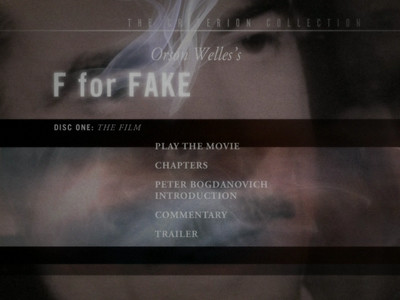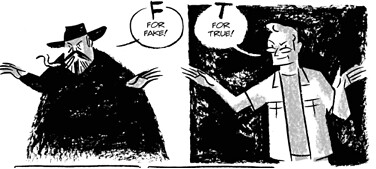DEVIOUS, TRUCULENT, & UNRELIABLE
In 2005, Image Comics released an anthology called Four-Letter Worlds
On page 3, there is a panel where Orson Welles, dressed in his magician's cape and hat, announces, "F for Fake!" The image and the phrase are from Welles' 1972 film of the same name, F For Fake, released as a double-disc Criterion DVD this past Tuesday. F For Fake is a bit of a legendary cult film, plagued by poor distribution like most of Welles' later movies. I had never seen it, just always heard about it. I'm not sure it had ever been made available on video.
And yet, here I was writing a tribute to it: a movie I had never seen, released the year I was born, inspiring an autobiographical short story in comic book format. Given Welles' penchant for storytelling in all its forms, I could see him liking that idea. In fact, this versatility was probably what drew me to him as a teenager. After being exposed to his first two films, Citizen Kane
So, something about this long-absent movie about the art of confidence and the confidence of art lodged itself in my brain. In addition to "(T For) True," there is a scene in my second novel, The Everlasting

The comics story was put to bed before Criterion officially announced the release of their DVD version (the rumors had been around for a while). Additionally, Andi and I had finished when I sat down to watch the 1988 documentary With Orson Welles: A Life in Film, a long interview with Welles where he discusses each of his films. It was sent to me by fellow Welles fan Ande Parks, author of Oni's Union Station and Capote In Kansas. As I watched it, I realized I had seen it before, probably when it first aired on one of the Turner cable channels. The timing would have been just about right. Much to my horror, though, when I got to the F For Fake section, the explanation of the film and the scenes they showed looked eerily familiar. I had, without knowing it, stolen them wholesale for my story, down to the winking revelation at the end. I was mortified.
Shortly after this, I had coffee with Matt Fraction, who was breezing through Portland. When I wasn't marveling at the abuse he was perpetrating on his rather ample lion's mane, we discussed our writing. Fraction has a story in Four-Letter Worlds, as well (he tackled "Fate" lock, stock, and smoking barrel). I explained to him what I had discovered, and he in turn told me that what I had done was not uncommon. Nabokov possibly did it with Lolita
This all made the DVD release of F For Fake even more exciting. How far had I gone in replicating Welles' cinematic practical joke?

Well, as it turns out. My tale is not an out-and-out theft as I feared, but the homage as intended, a tribute to a great premise. Whereas I dug into my own past to craft an autobiography of my love affair with fiction and its place in my life, Welles used F For Fake to look at a greater concept of art. If all art is a replication of something out of real life, then is a replication of art any less real? He uses two examples: Elmyr de Hory, a notorious forger of masterpieces by painters like Matisse and Modigliani, and Clifford Irving, who wrote Fake!
(Coincidentally, Andi Watson explored similar ideas of real vs. fake in his graphic novel Geisha, about an android artist hired to forge a Vermeer. His heroine, Jomi, faces accusations that her own art can't be real, since she herself is synthetic. Yet, in a world of plastic surgery and drugs that make us feel ways other than what comes natural, who is more false?)
F For Fake is an enchanting, fun flick. As far as Welles' movies are concerned, it is probably his most playful film. He clearly had a blast in the editing room, even shooting some of his own scenes there, using the monitor to remind us that we are watching a movie, which is itself a forgery of reality. Fiction and truth are manipulated with the same tools. Welles takes interview footage that, by its nature, has an air of authenticity, and twists it to meet his demands. Reaction shots are taken out of context, often frozen for comical effect, and used to create doubt about whatever truth is being told. Elmyr gives Irving an eye roll, Irving looks skeptically at Elmyr, wondering if he believes his own self-crafted legend.
Amidst all of this intercutting, Welles takes center stage as a storyteller. He is almost like a boorish party guest that won't let his host tell his own tales, he always has to break in and give his own embellishment. Yet, the effect is utterly charming and releases each anecdote from the bondage of its teller. Like the art forgeries and the great masterpieces in museums across the world, they belong to all. The reality is in the eye of the beholder, in the voice of the teller.

In the end, Welles' ultimate trick is to one-up his audience. We've believed his promise to tell us the truth, and we are willing to accept that all the way to the end. Like the magician who has gotten us on board with a well-executed illusion, Welles pulls a bait-and-switch. As we thrill to the rush of tales about art forgery and the long con, he slips us a mickey: a fake tale with true players, and we swallow it whole. As he unveils his own chicanery, he uses the visual metaphor of a magician levitating a man, covering him in a sheet, and then pulling off the sheet to reveal, much to his delight and ours, that the man isn't floating in mid-air--because he isn't even there.
I am sure that after the film was released, Welles was consistently asked to debunk F For Fake. Part of the fun is keeping people on their toes. In my story, I note that the script harbors a lie and promise to never reveal what it is. If you ask me, the best answer you will likely get is, "Who knows? Maybe the lie is when I tell you there's a lie in the story. Maybe every word of it is true. Because if the lie is saying there is a lie, then that is true, too." However, for those of us who want to go beyond the film, who want to know if Elmyr de Hory and Clifford Irving really did what F For Fake says they did, Criterion has given us a second disc with documentaries on both men, as well as one on Welles. To tantalize us a little bit more, there is also the 1972 press conference where Howard Hughes denounced Irving--though he does it by phone, which Welles suggests in the movie means we can't ever know for sure if it was really Hughes or not. If Orson is messing with us, we don't care. His greatest feat of magic is convincing us we want to be duped. Over and over again.


No comments:
Post a Comment